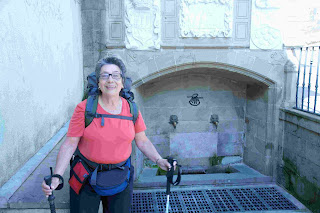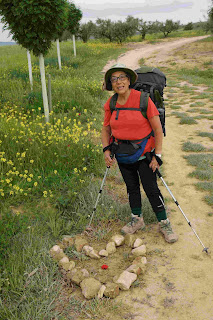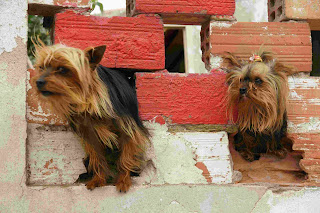
After a couple of tries, Encarnita decided that in general she preferred private accommodation to group sleep in a community hostal. We will discuss this issue further before we set off on next year’s journey. She was heard to comment that she thought this one in the town of Agés was tolerable. It helped that the lady in charge came from the Andalucian town of Tarifa, where Encarnita’s grandfather had been borne, and recognized his name.

On top of Matagrande (literally translated as “big killer”) we encountered a shepherd who was picking up several lambs that had been borne that evening. He was also encouraging the formation of a series of concentric circles by having each pilgrim who passed add a stone or two. I cannot image what theories archeologists ten centuries from now might ascribe to this uncommon ruin.

At this point our pilgrimage for 2008 closes. We reached Burgos, having walked around the airport and along the five kilometres of industrial activity that mark the eastern end of this beautiful city. As planned we rented a car to leave the Camino and drive fifty kilometres south to the medieval town of Santo Domingo de Silos, where the monks still perform the church rites to the sound of Gregorian chant. Our hotel was a small renaissance palace. The monastery is famous for, in addition to its music, an exquisite cloister whose colonnade is topped by detailed and varied capitals.


After an evening in Santo Domingo and a visit to Covarrubias, we returned to Burgos. Instead of continuing our pilgrimage as planned, however, we decided to end it for this year. Encarnita had a bad cold and the weather forecasts promised continuing rain and cold. We would pick up the Camino next year at Burgos, rather than at Sahagún, as originally planned.


































 The entry into Logroño passes over a hill that was once the site of Celtic community. Before one can see modern day Logroño, however, one comes to the stand of Felisia. For fifty years Felisia offered beverages to passing pilgrims. She even had her own stamp for the pilgrims passports. When she died six years ago, her daughters took over the responsibility. They had no difficulty knowing when pilgrims were passing by, as each one was announced by their dogs.
The entry into Logroño passes over a hill that was once the site of Celtic community. Before one can see modern day Logroño, however, one comes to the stand of Felisia. For fifty years Felisia offered beverages to passing pilgrims. She even had her own stamp for the pilgrims passports. When she died six years ago, her daughters took over the responsibility. They had no difficulty knowing when pilgrims were passing by, as each one was announced by their dogs. Logroño has interesting churches as well as excellent wine. At the Church of Santiago, where we attended the pilgrims mass, Saint James the Moorslayer was in full fight over the portal, encouraging us on our way.
Logroño has interesting churches as well as excellent wine. At the Church of Santiago, where we attended the pilgrims mass, Saint James the Moorslayer was in full fight over the portal, encouraging us on our way.









